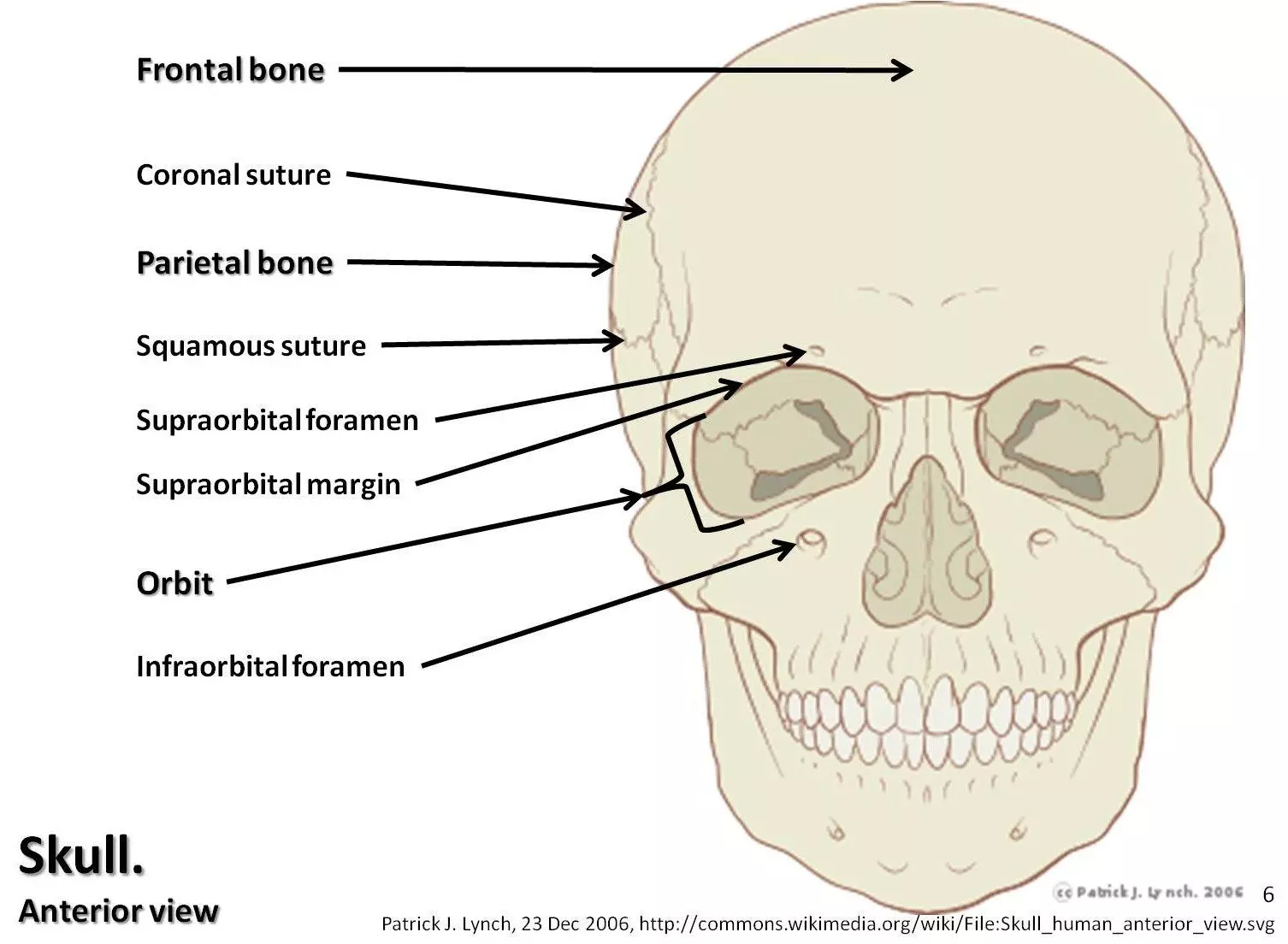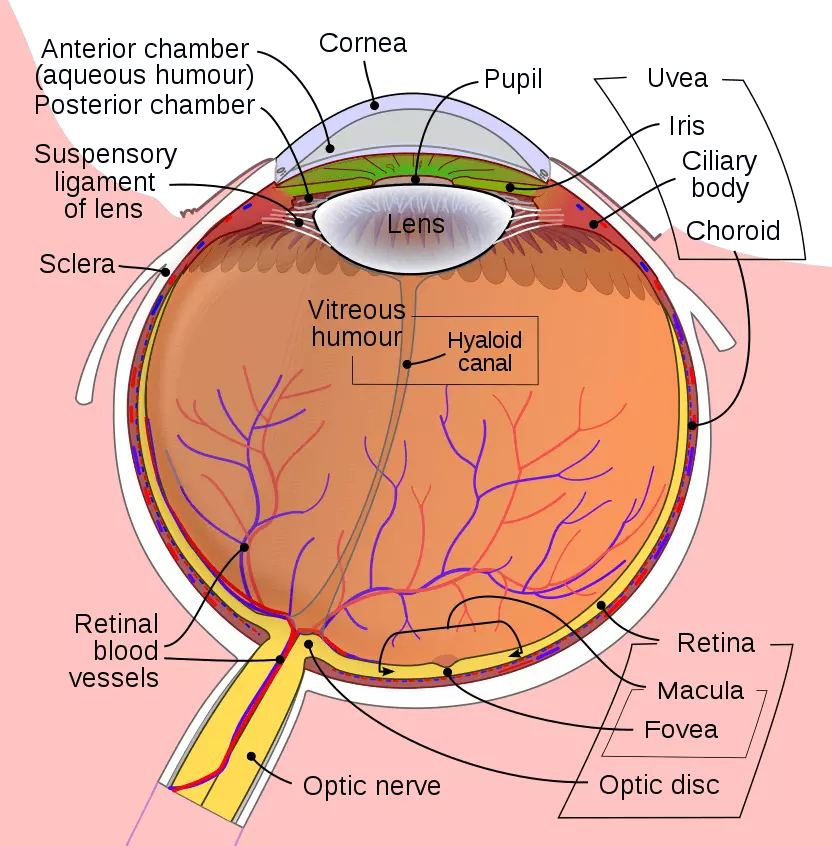Next Lesson - The Larynx
Abstract
- The eyes sit in the orbital cavity of the skull, which is roughly shaped like a square based pyramid pointing inward. There are two main fracture types in the orbit: of the rim, or a blow-out fracture of the orbit itself.
- The eyeball has three layers. The outer, fibrous layer is called the sclera. The middle, vascular layer is made up of the choroid, ciliary body, and iris. The inner layer is called the retina and contains the rods and cones.
- The lens sits anteriorly in the eye, posterior to the pupil. It focuses the light on the macula. The lens can change shape to allow focus on objects that are closer or further away.
- The anterior and posterior chambers are filled with aqueous humour to nourish the eye. It is produced in the ciliary body and drains through the trabecular meshwork; a blockage in this mesh can cause glaucoma. If this blockage occurs acutely, it can threaten sight immediately. If it is chronic, it can threaten sight, but over the longer term.
- The back of the eye contains vitreous humour that keeps the retina pushed out.
- The eyelid has 5 portions, superficial to deep: skin, orbicularis oculi muscle, tarsal plates, levator apparatus, and the conjunctiva. Infections of the Meibomian glands or hair follicles can cause styes.
- The lacrimal gland produces tears, which drain into the lacrimal sac and into the nasolacrimal duct.
- The eye is a complex structure that can develop pathologies that affect vision. Cataracts make the lens cloudy. The eye can be an abnormal shape affecting where light is focused (astigmatism). The retina can become damaged. The eyes can point in different directions (squint), which confuses the occipital lobe.
- Infections of the orbit can be classified as pre-septal or post-septal depending on their relationship to the tarsal plate. Post-septal cellulitis is very serious and needs urgent assessment and treatment.
Core
The eyes sit in the orbital cavity of the skull, obscuring the optic canal, superior and inferior orbital fissures (these can be seen at the base of the orbit in the image below).
The orbital cavity itself is similar in shape to a square based pyramid (with the tip pointing towards the back of the skull); each of the sides of the square based pyramid are made up of different skull bones:
- Medial Wall – ethmoid bone, lacrimal bone, maxilla and sphenoid bone
- Roof (superior) – frontal bone and lesser wing of the sphenoid bone
- Lateral wall – zygomatic bone and greater wing of the sphenoid bone
- Floor (inferior) – maxilla, palatine bone and zygomatic bone
- Apex – the optic foramen, which is the opening to the optic canal
- Base – opens out into the face, known as the orbital rim
Superior to the orbit is the anterior cranial fossa, separated by the frontal bone.
Inferior to the orbit is the maxillary air sinus, separated by the maxilla.
Medial to the orbit is the ethmoid air sinus, separated by the ethmoid bone.

Diagram - The anatomy of the anterior portion of the skull. The orbit is the shape of a square-based pyramid, with the base being at the surface of the skull and the point deep into the skull
Creative commons source by Rob Swatski [CC BY-SA 4.0 (https://creativecommons.org/licenses/by-sa/4.0)]
When a large force meets the orbital cavity (e.g. a right hook from a boxer’s punch) a number of different types of fracture can occur.
Orbital Rim Fractures
This is a fracture of the orbital rim, which is the bony edge to the orbit on the face. They commonly occur at the sutures joining the orbital rim. Therefore, the maxilla, zygomatic bone and frontal bone can all be fractured.
Orbital ‘Blowout’ Fractures
With a direct hit to the orbit, the eyeball may be pushed back into the cavity due to the sudden increase in intra-orbital pressure. This can fracture the bones of the orbit, most commonly the floor (maxilla) and the medial wall (ethmoid bone) which are the weakest points of the orbit. The maxilla and ethmoid are notably weak in these positions as they over lie air sinuses leaving only thin bone.
This can create problems with eye movement if contents of the orbit like the extra-ocular muscles herniate into the maxillary or ethmoid sinus. The patient will usually also suffer damage to the infraorbital nerve, a branch of cranial nerve Vb, leading to paraesthesia of the underlying teeth, gum and cheek. The patient will classically present with a history of trauma and double vision with periorbital swelling, a sunken eye and reduced eye movements on the affected side.
There are three layers to the eyeball.
The outer layer is also known as the fibrous layer. It consists of the sclera, which is the white of the eye and covers most of the eyeball, and the cornea, which is continuous with the sclera but covers the iris and pupil and is transparent. The cornea provides the majority of the eye’s focusing power but cannot change its focus.
The middle layer is very vascular, and is made up of the choroid, a connective tissue support structure which is continuous with the ciliary body, which controls the shape of the lens of the eye, and the iris, the coloured, smooth muscle structure that controls the shape of the pupil.
The inner layer is the retina, the light detecting portion of the eye. The pigmented layer covers the whole of the inside of the eyeball and is responsible for support in the eye, and the neural layer which contains the photosensitive cells; rods and cones. Centrally, the cones are more prevalent to gather as much light as possible which is focused onto the retinal and improve colour vision. Peripherally, the rods are more prevalent, meaning even low levels of light can be detected in peripheral vision.
Posteriorly on the retina is the attachment of the optic nerve which transports the information from the photosensitive cells to the occipital lobe of the brain. This point of attachment is called the optic disc, and there are no photosensitive cells here, meaning any light focused onto this area is called not detected, producing a ‘blind spot’.
The lens of the eye is located anteriorly in the eyeball and sits behind the pupil. Its purpose is to refract the light that enters through the aperture of the pupil to focus the image on to the retina. The point at which the light is focused is called the macula. The cones are very densely packed in the macula to allow the best interpretation of the light possible.
The shape of the lens can be altered to change the angle of refraction. This allows the eye to focus on objects that are near or far away, and is done through the action of the ciliary muscles.
The accommodation reflex is responsible for focusing on objects that are closer, which requires a greater power of refraction. The eye accommodates by:
- Constricting the pupil – less light entering so less light to refract
- Eyeballs converge – focus the image on one point
- Lens becomes more biconvex (shorter and fatter) – contraction of the ciliary muscle reduces tension on the ligaments that connect it to the lens allowing the lens to relax and widen.
As age increases, the lens becomes stiffer so that refraction is less precise. Presbyopia (age related long sightedness – inability to see objects close up) can be corrected by reading glasses.
The eye has two main segments or cavities, the anterior segment and the posterior segment. There anterior segment is made up of the anterior chamber which sits between the cornea and the iris, and the posterior chamber, which sits between the iris and the ciliary processes, just lateral to the lens.
These chambers of the anterior segment are filled with aqueous humour, a clear fluid that is similar in composition to the plasma component of blood. Its function is to nourish and protect the eye. It is produced continuously by the ciliary body found in the posterior chamber and moves towards the anterior chamber through the pupil. It drains through the iridocorneal angle via the trabecular meshwork, a structure located at the base of the cornea, close to the anterior chamber.
Because the aqueous humour is produced at a constant rate, obstruction to the outflow of this humour can increase the pressure inside the eye (increased intraorbital pressure). This is a condition called glaucoma and can lead to vision loss due to damage occurring to the optic nerve.
Posterior to the lens is the posterior segment which mainly consists of a large space filled with vitreous humour. This is responsible for keeping the spherical shape of the eyeball and holding the retina in place at the back of the eye.

Diagram - The structure of the eyeball. Note the position of the anterior and posterior chambers
Creative commons source by Rhcastilhos and Jmarchn [CC BY-SA 4.0 (https://creativecommons.org/licenses/by-sa/4.0)]
Structures that Surround the Eye
The eyelids are more than flaps of tissue; they have five layers.
The most superficial layer of the eyelid is the skin and subcutaneous tissue.
The next layer is the orbicularis oculi muscle. It has three portions:
- Palpebral portion – gently closes the eyelids
- Lacrimal portion – involved in the drainage of tears
- Orbital portion – tightly closes the eyelids
The orbicularis oculi originates from the medial orbital margin and the lacrimal bone. It inserts into the skin around the edge of the orbit, and the tarsal plates. It is innervated by the temporal and zygomatic branches of the facial nerve (cranial nerve VII).
The tarsal plates act as a scaffolding of the eyelid and are made of dense connective tissue. They contain the Meibomian glands, a specialised type of sebaceous gland that secretes oil onto the surface of the eyeball to prevent rapid evaporation of the tears. If the Meibomian glands become blocked, they can cause a non-painful swelling called a Meibomian cyst. The tarsal plates also hold the hair follicles for the eyelashes.
The tarsal plate can be a site of infection. A stye is caused by infection of the hair follicles usually by Staphylococcus aureus. These conditions are usually self-limiting but can be painful.
The orbital septum is derived from periosteum and forms a fibrous sheet which blends with either the tarsal plate or levator palpibrae superioris.
The next layer of the eyelid is the levator apparatus, a combination of two structures that act to open the eyelid. The two structures are the levator palpebrae superioris, innervated by the oculomotor nerve, and the superior tarsal muscle, innervated by sympathetic fibres from the superior cervical ganglion of the sympathetic chain.
The deepest layer of the eyelid is the conjunctiva. This is the thin mucous membrane that covers the eyeball and is continuous with the inside of the eyelid.
The lacrimal apparatus is made up of the lacrimal gland and the lacrimal sac.
The lacrimal gland is positioned superolaterally in the orbit and is responsible for the production of tears. These are spread across the eyeball through blinking.
The lacrimal sac which lies at the medial edge and extends down vertically as the nasolacrimal duct is responsible for draining tears into the nasal cavity.
Muscles of the eye and orbit can be split into two groups:
- Extrinsic muscles are the muscles of the eyelid and the extra-ocular muscles that generate eye movements, receiving somatic innervation.
- Intrinsic muscles are those which control the iris (dilator and constrictor of the pupil) and the ciliary muscles that controls the thickness of the lens, receiving autonomic innervation. Note that the superior tarsal muscle of the eyelid also receives autonomic innervation.
For more information on the extra-ocular muscles, and associated pathology, please our article on ‘Cranial Nerves I – VI’.
Pathology in the eye can fit into a few general categories:
- Structures are less/no longer transparent
- Change in ability to refract light
- Retinal pathology
- Loss of coordination between the eyes
If structures are less transparent, the light that reaches the retina can become blocked, reduced or distorted, resulting in an unclear image. This can happen, for example, if the lens of the eye develops cataracts, and becomes cloudy thus scattering any light which tries to enter the eye.
If the eye cannot effectively refract light, the light will not be properly focused on the macula. As a result, the image will not be clear. This may happen because the lens has stiffened (for example, with age – presbyopia), the cornea has an irregular shape (astigmatism) or the eyeball is an unusual shape.
Short-sighed vision (myopia) is usually caused by lens pathology which causes light to focus at a point in front of the retina or by an elongated eyeball causing the same effect. Long-sighted vision (hypermetropia) is usually caused by lens pathology which causes light to focus at a point behind the retina, or by a short or small eyeball.
If the retina itself (including its components such as the macula and fovea) is damaged, then the detection of light will be affected. This can happen with retinal detachment, macular degeneration and optic neuritis.
Binocular vision relies on both eyeballs being able to look at the same point. If there is a squint or a cranial nerve palsy that causes the eyes to not align to look at the same points, then when the occipital lobe merges the images together there will be double vision (diplopia).
Infections of the eye can be classified by their location in relation to the tarsal plate.
Infections that are anterior to the orbital septum are examples of pre-septal cellulitis. This infection is marked by preserved ocular motion as the infection is still in front of the tarsal plates, and can be managed in the community with oral antibiotics. It presents much more superficially, with little swelling and localised redness.
In contrast to pre-septal cellulitis, post-septal or orbital cellulitis is considerably more serious. The infection is behind the orbital septum and can affect the structure of the eye itself. Therefore ocular movement is reduced (and may be painful) along with reduced visual acuity. It presents with much more drastic swelling and redness, that may push the eye outwards (proptosis). These infections are also at risk of tracking backwards to any site the orbital veins drain into with the potential to cause a cavernous sinus thrombosis or meningitis.
In practice it can be relatively difficult to differentiate between the two conditions so if there is any doubt as to whether a patient has pre-septal or post-septal cellulitis, immediate referral to a specialist eye emergency department for rapid assessment and treatment of infection and to preserve sight is required.
As previously mentioned, glaucoma is a condition of increased pressure inside the eyeball, caused by a build-up of aqueous humour due to abnormalities with its drainage through the trabecular mesh. It can be classified into open angle and closed angle glaucoma.
In open angle glaucoma, the trabecular mesh network is deteriorating but there is still a degree of drainage of aqueous humour. This will cause a gradual increase in intraocular pressure, leading to optic disc cupping and progressive peripheral vision loss due to the pressure effect.
Closed angle glaucoma (acute glaucoma) is an uncommon condition which is an ophthalmological emergency that is sight threatening. Caused by acute narrowing between the iris and the trabecular meshwork. There is a drastic increase in intraocular pressure due to the build up of aqueous humour. This can rapidly damage the optic nerve and lead to vision loss. A closed angle glaucoma presents with an acutely painful red eye, an irregularly shaped and fixed pupil, blurred vision, seeing ‘halos’ around light sources, nausea and vomiting. Management is based around medicines to reduce intraocular pressure and then operative intervention to relieve the pressure.
Edited by: Dr. Ben Appleby
Reviewed by: Dr. Thomas Burnell
- 2679

